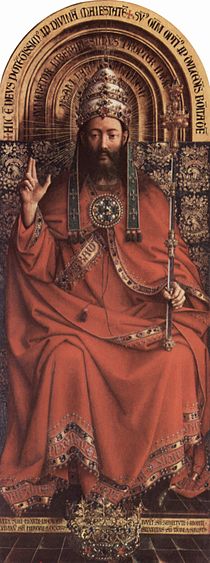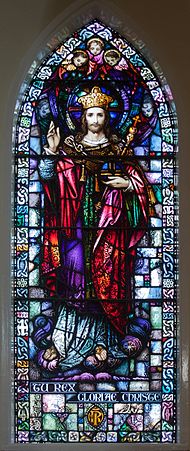Christ the King

Christ the King is a title of Jesus in Christianity referring to the idea of the Kingdom of God where the Christ is described as seated at the Right Hand of God[1] (as opposed to the secular title of King of the Jews mockingly given at the crucifixion).
Many Christian denominations consider the kingly office of Christ to be one of the threefold offices: Christ is a prophet, priest, and king.[2]
The title "Christ the King" is also frequently used as a name for churches, schools, seminaries, hospitals, and religious institutes.
Biblical basis
The titles of "Christ" and "king" are not used together in the gospel, but "Christ" is in itself a royal title (i.e. "the anointed [king]"). In the Greek text, the Christ is explicitly identified as king (βασιλεύς) several times, so in Matthew 2:2 ("Where is the newborn king of the Jews?"). In John 18, Pilate refers to the implication that the Christ is a royal title by inquiring explicitly if Jesus claims to be the "king of the Jews" (βασιλεὺς τῶν Ἰουδαίων). Similarly, in John 1:49, a follower addresses Jesus as "the king of Israel" (ὁ βασιλεὺς τοῦ Ἰσραήλ).
In the Gospel of Luke, the angel Gabriel proclaims, "Behold, you will conceive in your womb and bear a son, and you shall name him Jesus. He will be great and will be called Son of the Most High,* and the Lord God will give him the throne of David his father, and he will rule over the house of Jacob forever, and of his kingdom there will be no end."[3] In the Book of Revelation it is declared that the Lamb is "King of kings, and Lord of lords."[3]
Outside of the gospel, the First Epistle to Timothy (6:14–15) explicitly applies the phrase of "king of kings and lord of lords" (Βασιλεὺς βασιλέων καὶ κύριος κυρίων), taken from the Pentateuch (Deuteronomy 10:17) to Jesus Christ.
Background
The concept of Christ as king was the subject of an address given by Eusebius about AD 314. Depictions of the imperial Christ arise in the later part of the fourth century.[4]
Pius XI

Ubi arcano Dei consilio
Pope Pius XI's first encyclical was Ubi arcano Dei consilio of December 1922. Writing in the aftermath of World War I, Pius noted that while there had been a cessation of hostilities, there was no true peace. He deplored the rise of class divisions and unbridled nationalism, and held that true peace can only be found under the Kingship of Christ as "Prince of Peace". "For Jesus Christ reigns over the minds of individuals by His teachings, in their hearts by His love, in each one's life by the living according to His law and the imitating of His example."[5]
Quas primas
Christ's kingship was addressed again in the encyclical Quas primas of Pope Pius XI, published in 1925. Michael D. Greaney called it "possibly one of the most misunderstood and ignored encyclicals of all time."[6] The pontiff's encyclical quotes with approval Cyril of Alexandria, noting that Jesus's kingship was given to him by the Father, and was not obtained by violence: "'Christ,' he says, 'has dominion over all creatures, a dominion not seized by violence nor usurped, but his by essence and by nature.'" He also referenced Leo XIII's 1899 Annum sacrum wherein Leo relates the Kingship of Christ to devotion to his Sacred Heart.[7]
Pope Pius XI instituted the feast of Christ the King in 1925 to remind Christians that their allegiance was to their spiritual ruler in heaven as opposed to earthly supremacy. Pope Benedict XVI remarked that Christ's kingship is not based on "human power" but on loving and serving others.[8]
The hymn "To Jesus Christ Our Sovereign King", was written by Msgr. Martin B. Hellrigel in 1941 to the tune "Ich Glaub An Gott".[9]
Feast of Christ the King

The Feast of Christ the King was instituted by Pope Pius XI in 1925. The General Roman Calendar of 1969 moved its observance in the Roman Rite to the last Sunday of Ordinary Time, the final Sunday of the liturgical year. Most Anglicans and some Protestants celebrate it on the same day. However, Catholics who observe the pre-Vatican II General Roman Calendar of 1960, and members of the Anglican Catholic Church celebrate it instead on the last Sunday of October, the Sunday before All Saints' Day, the day assigned in 1925.
Institutions named after Christ the King

Many religious facilities are named in honor of Christ the King:
- Christ the King Cathedral, Kottayam, India
- Our Lord Christ the King Church In Cincinnati, Ohio - First Roman Catholic parish church in the world dedicated under that title
- Basilica of Christ the King, Reykjavík, Iceland
- Christ the King Cathedral, Mullingar – First cathedral in the world to be dedicated under that title
- The Metropolitan Cathedral of Christ the King, Liverpool
- Christ the King Cathedral, Hamilton, Ontario, Canada
- Cathedral of Christ the King, Atlanta, Georgia[10]
- Cathedral of Christ the King (Lexington, Kentucky)[11]
- Cathedral of Christ the King (Lubbock, Texas)[12]
- Christ the King Cathedral, Tagum Davao del Norte, Philippines
- Christus Koningkerk (in Dutch), parish church originally built for the 1930 World's Fair, Antwerp, Belgium (in Dutch)
- Rīgas Kristus Karaļa draudzes baznīca (Riga's Christ the King's parish church), Riga, Latvia
- Shrine of Christ the King Sovereign Priest, Chicago, Illinois
- Christ the King Church, Sector 19, Chandigarh, India
- Christ the King church, Pammal, Chennai, India
- Christ the King Church, Dorgachola, Mymensingh, Bangladesh
- Christ the King Anglican Church (also known as Christ the King Garrison Church), Tripoli, Libya
- Christ the King Catholic Church, Mdantsane, East London, South Africa
- Christ the King Catholic Church, Silver Spring, Maryland [13]
- Christ the King Reformed Episcopal Church, Pasadena, Maryland
- the Church of Christ the King, Bloomsbury, London, England
- Christ the King Presbyterian Church, Houston, Texas[14]
- Christ the King Episcopal Church, Stone Ridge, New York[15]
- Christ the King Church, Kottappuram, Mulavana (via), Kollam, Kerala, India
- Christ the King Baptist Church, Dacula, Georgia[16]
- Christ the King Parish, Mashpee, Massachusetts
- Christ the King Catholic Mission, Riegelwood, North Carolina
- Christ the King Seminary, Diocese of Buffalo, East Aurora, New York [17]
- Christ the King Roman Catholic Church and School, Denver, Colorado[18]
- Christ the King Catholic School and Church, North Rocks, Australia
- Christ the King Catholic Church and School, Winnipeg, Manitoba, Canada
- Christ the King Catholic Church and School, Little Rock, Arkansas
- Christ the King Catholic Church and School, Pleasant Hill, California
- Christ the King Chapel, St. Ambrose University, Davenport, Iowa
- Christus Rex Lutheran Campus Center, Grand Forks, North Dakota
- Christ the King Catholic High School, Southport, UK
- Christ the King High School, St. John's, Antigua
- Christ the King Catholic Secondary School, Nottingham, England
- Institute of Christ the King Sovereign Priest, A Roman Catholic Society of Apostolic Life
- Christ the King University College, London, Ontario
- Christ the King Anglican Church, Maryborough, Victoria, Australia
See also
- Jesus is Lord
- Christ Pantocrator—a specific depiction of Christ, especially in Orthodox Christianity
- Cristo Rei, the Portuguese translation used for several place names
- Cristo Rey, the Spanish translation used for several place names
- Feast of Christ the King
- The Kingdom of God and the Kingdom of Heaven are theological concepts interpreted variously
- Kingly office of Christ, one of the Threefold offices
- Cornelius Lucey, Christus Rex Society, 1941
- Peter McKevitt, Christus Rex Society, 1941
- Ubi arcano Dei consilio
- Throne of God
References
- ^ Philip Edgecumbe Hughes, A Commentary on the Epistle to the Hebrews, p. 401, 1988: "The theme of Christ's heavenly session, announced here by the statement he sat down at the right hand of God, .. Hebrews 8:1 "we have such a high priest, one who is seated at the right hand of the throne of the Majesty in heaven")"
- ^ The Cyclopedia of Biblical, Theological, and Ecclesiastical Literature. James Strong and John McClintock; Harper and Brothers; NY; 1880
 This article incorporates text from this source, which is in the public domain.
This article incorporates text from this source, which is in the public domain.
- ^ a b Hodge, Archibald Alexander, "The Kingly Office of Christ", Popular Lectures of Theological Themes, Presbyterian Board of Publication and Sabbath-School Work, 1887, p. 260
 This article incorporates text from this source, which is in the public domain.
This article incorporates text from this source, which is in the public domain.
- ^ Beskow, Per. Rex Gloriae: The Kingship of Christ in the Early Church, Wipf and Stock Publishers, 2014, ISBN 9781625646415
- ^ Pope Pius XI. "Ubi Arcano Dei Consilio", 23 December 1922
- ^ Greaney, Michael D.A Just Third Political Way The Concept of Sovereignty in Quas Primas Social Justice Review Archived October 20, 2010, at the Wayback Machine
- ^ O'Donnell, Timothy Terrance. Heart of the Redeemer, Ignatius Press, 1992 ISBN 9780898703962
- ^ Christ's Kingdom not based on human power, Pope says (Catholic World News Nov. 27, 2006)
- ^ "To Jesus Christ Our Sovereign King", Hymnary.org
- ^ Cathedral of Christ the King, Atlanta, Georgia
- ^ Cathedral of Christ the King, Lexington, Kentucky Archived 2013-10-01 at the Wayback Machine
- ^ Christ the King Cathedral, Lubbock, Texas
- ^ Christ the King Catholic Church, Silver Spring, Maryland Archived 2014-11-22 at archive.today
- ^ Christ the King Presbyterian Church, Houston, Texas
- ^ Christ the King Episcopal Church, Stone Ridge, New York
- ^ Christ the King Baptist Church, Dacula, Georgia
- ^ Christ the King Seminary, Diocese of Buffalo
- ^ Christ the King Roman Catholic Church, Denver, Colorado
